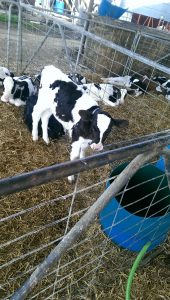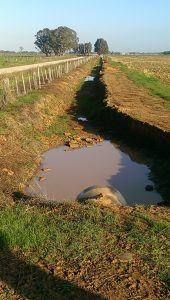 My name is Rhys Moller. I’m heading into my junior year at Cornell University where I’m in the Agricultural Sciences degree. I’m still not quite sure why I chose to study agriculture, I think mostly it’s because at the time I liked working outside and hated the idea of sitting in an office all day. I came into university with no knowledge of anything agriculture related, so I decided to contact my uncle in Australia, who works as an irrigation expert at a company called Rubicon Water. We decided that after sophomore year I should go to Australia for my internship credit, and go on a six week working tour across all kinds of agricultural entities in Melbourne, Brisbane, Shepparton, Sydney, Wee Waa, Echuca, and a handful of small towns in Northern Victoria.
My name is Rhys Moller. I’m heading into my junior year at Cornell University where I’m in the Agricultural Sciences degree. I’m still not quite sure why I chose to study agriculture, I think mostly it’s because at the time I liked working outside and hated the idea of sitting in an office all day. I came into university with no knowledge of anything agriculture related, so I decided to contact my uncle in Australia, who works as an irrigation expert at a company called Rubicon Water. We decided that after sophomore year I should go to Australia for my internship credit, and go on a six week working tour across all kinds of agricultural entities in Melbourne, Brisbane, Shepparton, Sydney, Wee Waa, Echuca, and a handful of small towns in Northern Victoria. 
The goals for the internship being to solidify what I’d like to do for a job, identify any classes I should take to be better prepared to enter the workforce, and to get a close up look at how Australian farmers handle the unique issues they face with limited water supply, droughts, extreme flooding, and heavy government regulations on water. The first stop in this tour was a dairy farm half an hour out of Echuca with a Farmer called Russell Pell. He’s a very interesting guy. He started the dairy with his brother in the 70’s, he meets with politicians to discuss water regulations, and is one of the first farmers in his region to start using modern irrigation technology and automation. I was excited to meet him and spend time on the farm, though having no farm experience what-so-ever, the learning curve was huge.
Day 1). The first thing you should know about Victoria, a southern state in Australia, is that it can be quite cold. The first day on the farm there was frost and fog, none of which I was expecting. I instantly regretted my decision to not bring a winter jacket and for the entire first day I unfortunately wore jeans and a t-shirt, I don’t think I’ve ever been so cold. To make matters worse, the farm was so large that ATV bikes were the only convenient way to get around. If there’s one thing you take away from this blog, it should be that going 40-50 kilometers/hour on a ATV in the middle of winter with only a t-shirt is the most miserable thing you can possibly do. Especially when it’s so foggy that you end up hitting a fence and get launched into the pond nearby. Learn through experience I guess… Because it’s winter in Australia, farms are relatively inactive in terms of crop growth. The farms dry feed had been harvested a few weeks earlier, the irrigation of winter crops had taken place a week before I arrived, and a couple crew members were on vacation. However, there was still much to do. The first big job was to cover the dry feed with plastic and tires to prevent pest damage. It may come as a surprise to Americans, but cockatoos are considered a farm pest. They have very sharp beaks that damage feed covers, which results in a significant loss. Because of this farmers are allowed to shoot them, and that alone should say how much of a pest they are since Australia has very, very strict gun laws. They had started swarming around the dry feed stores, so Russell decided it was time to put the plastic cover and tires over it. Covering the feed took close to 3 hours of hard work in very muddy and wet conditions. I was so sore at the end that when I was walking to my ATV my legs gave out from exhaustion and I fell into a large pit of mud. Luckily it was pitch black so nobody saw a thing.
Day #2). This was a very busy day. We had to first move an excavator that was stuck in one of the irrigation panels. We drove the big tractor out with a bed to put the excavator on for transport. The excavator got out from the mud in no time, but when we put it on the trailer it was so heavy that the tractor couldn’t get out of the muddy pathway. We decided that I was going to have to drive the tractor out of the mud, while Mr. Pell was simultaneously used the escalator, stored on the trailer bed, arm to push the tractor out. Somehow this worked, and looking back it was actually very unsafe, having never driven a large tractor in my life. Not to mention the fact that the escalator constantly looked like it was going to fall backwards off the trailer with Mr. Pell in it. Good times… After that we had to round up some cattle that had been sold a couple weeks earlier for pickup. Not much action really, but it was good for me to see the whole loading process. The rest of the day was spent getting a view of the above ground water transport systems, which in Australia are huge channels of dirt, and the overall farm irrigation plan. In Australia, the use of flood irrigation is very common, and generally thought of as less expensive that lateral movement irrigators and pivot irrigators. The problem is that flood irrigation isn’t very efficient with water use. A farmer has to judge how quickly the water is moving across a field in order to judge when to stop the water flow in, and closing the channels can take time. Mr. Pell recently invested in automatic rubicon irrigation channel doors (pictured above), that are all connected via the cloud. Now he can simply use an app to close the channels, and even better, each time he irrigates the data is all collected and eventually averaged out. This means that he can open the channel doors, and with all the previous irrigation times stored, the doors will close on their own when the field is properly irrigated without wasting as much water as he would have previously.
Day #3). The third day was uneventful. Russell Pell had to leave for Australia’s capital, Canberra, to meet with politicians to discuss water policy related problems. While he was over in the capital, I went and did various jobs with the farm hands, I sat in the tractor with Peter, the head herdsman, and fed the cows. I went and cleared out the dairy after milking, which smelled awful, and mustered the cows from the dairy all the way across to the other corner of the farm. Herding the cattle was actually quite fun, even though these cows were obstinate to an extreme level. The farm hands looked on in laughter as I was standing on my quad bike, waving my arms and making as much noise as possible, attempting to get those cows to move. They showed me a video afterwards and I looked pretty ridiculous. Something of note, an immediate difference I noticed from how American dairy cows are raised to Australian cows is that Australian cows are always outside, and are only brought in to structures of any form to be milked. Though, I will admit that the only reason they can do that is the warm climate. A result of this is that there is lots of foreign investment and purchasing of Australian dairy products from China, who views Australian dairy products as clean and in much higher standards of quality than most Chinese produced milk.
Day #4). Woke up early again to go and clear the cattle sheds after milking, which ended up being cut short. One of the water pipes had apparently broken (shown above) and had to be fixed. It turns out that the original structure wasn’t put together very well, and that particular pipe was only half welded into place, so they’d been leaking water for a couple years without noticing. It took a couple hours to sort that issue out, mostly because the pipes in this particular dairy are also connected to the wiring, so in order to replace the pipe they had to also remove the wire cords. Once that whole drama was over, I went to go explore the intake pipes by the river. Farms in Australia are only allowed a certain amount of water, in Megalitres per year, to draw out of the water. Their intake is measured by a device placed inside the piping at the intake point. The first and second sets of pictures have examples of what the intake piping looks like. The water is drawn up into channels that then spread the water across the farm. Also present on a typical Australian farm is catchment dams. These are unregulated, which means that whatever water these dams keep after rainfall is yours to use. I’ll show some pictures of those in one of the next blog posts from the cotton farm.
Day #5). My last day on the farm was spent learning how to build fences, which is something that I never thought was going to be very difficult. Having now experienced that, I can comfortably say that it would take lots and lots of practice to finally string up a fence properly. I really enjoyed the experience on the farm, but I can comfortably say that i will not be pursuing a career as a dairy farmer. I’m not sure I could handle the constant smell, somewhat monotonous routine, and constant worrying about the international precise of dairy, but in the short term it was a great experience and I learned lots of practical skills for later in life. So yeah that’s week #1, next week I head to Sydney to go exploring. Even though I’ve done it too many times to count, I’ll likely do all the typical touristy things around the harbor area, but I’ll also be heading out to the Blue Mountains to explore what is in my opinion one of the most beautiful areas in the whole world, Katoomba. Next blog post will be from the cotton farm based out in Wee Waa.














